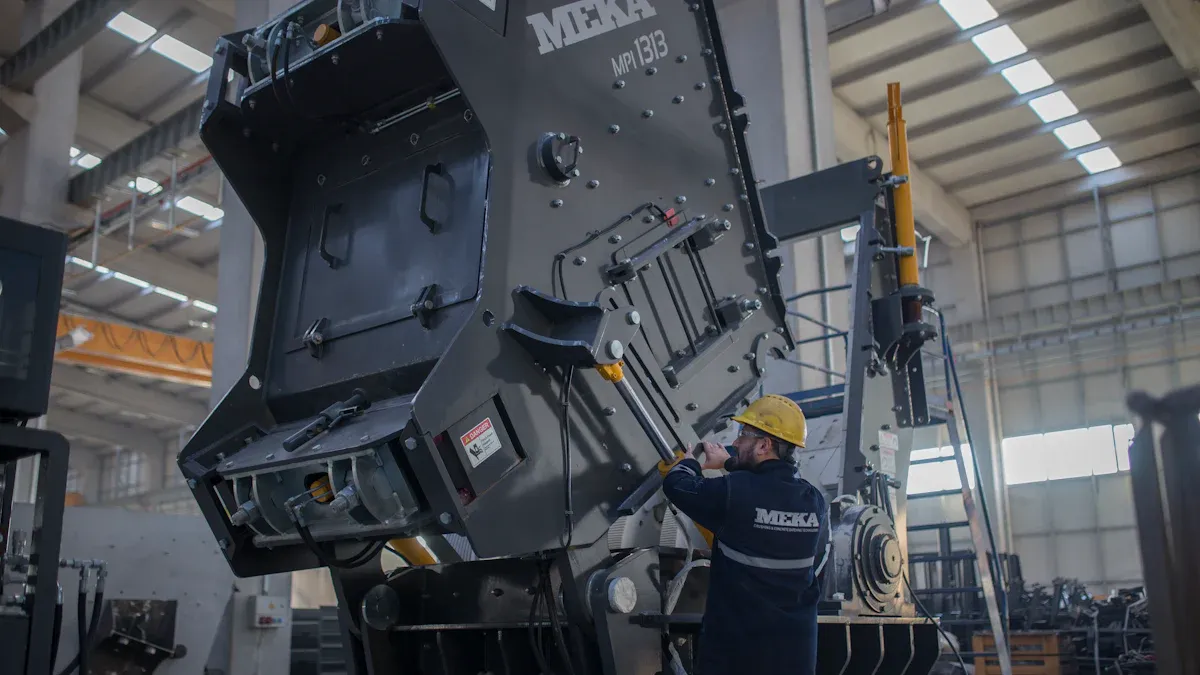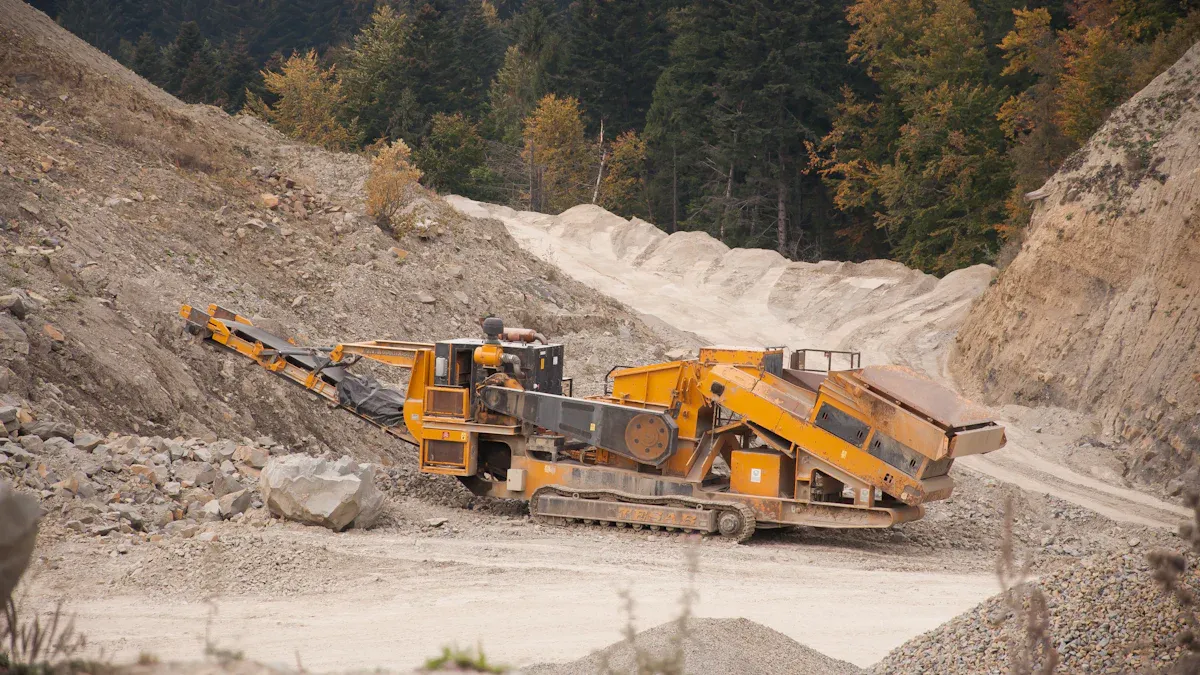
Choosing the right impact crusher blow bars ensures optimal performance and prevents costly issues. Blow bars play a critical role in crushing operations by breaking down materials efficiently. Poor selection, however, can lead to frequent breakages, increasing maintenance expenses. It also reduces the impact crusher’s performance, which drives up operational costs.
When selecting blow bars, you should consider factors like material type, design, and durability. Regular maintenance also extends their lifespan and keeps your crusher performing at its best. Careful evaluation helps you avoid unnecessary downtime and ensures smooth operations.

The material composition of blow bars directly impacts their performance and durability. You should select materials based on the type of material being crushed and the specific application.
| Type of Blow Bar | Material Composition | Advantages | Applications |
|---|---|---|---|
| Manganese Blow Bars | Manganese Steel | High shock resistance, elongation, suitable for tramp iron in feed | Primary crushers |
| Other Materials | Various alloys | Potential for significant life cost benefits | Specific applications based on needs |
Manganese steel blow bars work well in primary crushers where high shock resistance is essential. For specialized applications, alloy-based blow bars offer better cost-effectiveness and durability. Choosing high-quality materials ensures your impact crusher operates efficiently and minimizes blow bar breakage.
The design of blow bars influences their crushing efficiency and wear patterns. You should evaluate the design features carefully to match your application needs.
Types of Blow Bars:
Straight plate type
Crescent type
The crescent type offers higher crushing efficiency due to its larger impact surface and vertical impact design. This makes it ideal for applications requiring finer material output.
Fixing Methods:
Bolt fixation
Pressure plate fixation
Wedge fixation
Correct blow bar design and fixing methods ensure stability during operation, reducing wear and tear. For example, extended ceramic inserts in blow bars can reach up to 60 mm, significantly improving wear resistance and service life. This design feature helps you optimize maintenance schedules and predict wear rates effectively.
Not all blow bars fit every impact crusher model. You should verify compatibility to avoid operational issues. Manufacturers often provide specifications for blow bar dimensions and fixing methods.
When selecting blow bars, consider the crusher’s rotor size and the type of material being processed. Using incompatible blow bars can lead to uneven wear patterns and reduced performance. Matching the blow bars to your impact crusher ensures smooth operations and maximizes crushing efficiency.
Understanding wear patterns helps you evaluate the durability of impact crusher blow bars. Blow bar wear occurs due to constant contact with abrasive materials during crushing. Uneven wear patterns often indicate improper installation or material misalignment. Regular inspections allow you to identify these issues early and prevent blow bar breakage.
Durability depends on the material composition and design of the blow bars. For instance, manganese steel blow bars offer excellent shock resistance, making them ideal for high-impact applications. Alloy-based blow bars, on the other hand, provide better wear resistance and longer service life. Choosing the right material ensures consistent performance and reduces the frequency of replaceme nts.
The efficiency of your impact crusher directly relates to the design and performance of its blow bars. Efficient blow bars maximize material output while minimizing energy consumption. You can evaluate crushing performance by analyzing metrics such as surface production per unit of energy input.
Impact tests measure how effectively blow bars convert energy into material breakdown.
Grindability tests assess the energy application in pulverizing particles, helping you understand the blow bar's effectiveness.
These tests provide valuable insights into how well your blow bars perform under specific conditions. High-efficiency blow bars not only improve material output but also reduce operational costs by optimizing energy use.
Cost-effectiveness involves balancing initial investment with long-term savings. Durable blow bars may cost more upfront, but they reduce maintenance expenses and downtime. For example, alloy blow bars with ceramic inserts last longer and require fewer replacements.
Longevity also depends on proper maintenance practices. Regular cleaning and inspections prevent excessive wear, extending the life of your blow bars. By investing in high-quality blow bars and maintaining them properly, you can achieve better crushing performance and lower overall costs.

Proper maintenance is essential to extend the life of your impact crusher blow bars and ensure efficient operations. By following best practices, you can reduce the risk of blow bar breakage, minimize downtime, and improve overall performance.
Frequent inspections help you identify wear patterns and potential issues before they escalate. Monitoring wear ensures that blow bars remain effective and reduces the risk of unexpected failures.
Key Indicators of Improper Wear:
Observing performance indicators can help you detect problems early. The table below outlines common wear issues and their symptoms:
| Blow Bar Improper Wear | Observable Performance Indicator |
|---|---|
| Over Feeding | High rotor loading and engine load spikes. |
| Under Feeding | Uneven conveyor output and low engine load. |
| Grinding | Reduced production and excessive apron movement. |
Tips for Effective Monitoring:
Check for uneven wear patterns during routine inspections.
Monitor engine load and conveyor output for irregularities.
Adjust feeding conditions to prevent overloading or underfeeding.
By staying vigilant, you can address wear issues promptly and maintain consistent performance.
Pro Tip: Use a preventive maintenance program to schedule regular inspections and avoid costly repairs.
A preventive maintenance program ensures your equipment operates efficiently and reduces the likelihood of blow bar breakage. Cleaning and maintaining your impact crusher regularly can significantly extend the lifespan of its components.
Steps for Preventive Maintenance:
Inspect blow bars for cracks or excessive wear during scheduled maintenance.
Clean the crusher to remove debris that could accelerate wear.
Lubricate moving parts to reduce friction and prevent overheating.
Benefits of Preventive Maintenance:
Reduced risk of breakage due to early detection of issues.
Improved crushing efficiency and material output.
Lower operational costs by minimizing unplanned downtime.
Note: A well-implemented preventive maintenance program not only extends the life of your blow bars but also enhances the overall performance of your impact crusher.
Installing and replacing blow bars correctly is crucial for maintaining crusher efficiency and avoiding unnecessary wear. Improper installation can lead to uneven wear patterns and frequent replacements.
Best Practices for Installation:
Train operators to handle blow bar installation and replacement properly.
Ensure blow bars are securely fixed using the appropriate method (e.g., bolt fixation or wedge fixation).
Align blow bars correctly to prevent material misalignment and grinding.
Guidelines for Replacement:
Replace blow bars when wear reaches the manufacturer’s recommended limit.
Use high-quality replacement parts to ensure compatibility and durability.
Plan for upgrades to adapt to new materials or increased production demands.
Reminder: Proper installation and replacement techniques reduce downtime and improve the longevity of your blow bars, saving you time and money in the long run.
Choosing the right blow bars for your impact crusher ensures efficient operations and reduces costs. Material selection, design features, and performance indicators play a vital r ole in optimizing crushing efficiency. Regular maintenance, including inspections and proper installation, extends the lifespan of blow bars and minimizes downtime. By making informed decisions, you improve crusher performance and achieve long-term savings.
Tip: Evaluate your blow bar needs based on your application and crusher model to maximize productivity.
A blow bar is the key component in an impact crusher. It breaks down materials by applying high-impact force. Its design and material composition directly influence the crusher's efficiency and durability.
For recycling applications, select blow bars made from durable materials like alloy steel or ceramic inserts. These materials resist wear and handle abrasive materials effectively, ensuring consistent performance and longer service life.
Yes, blow bars are essential for mobile impact crushers. They ensure efficient material breakdown during on-site operations. Always verify compatibility with your crusher model to avoid performance issues.
Inspect blow bars regularly, ideally after every 40 hours of operation. Frequent inspections help you identify wear patterns early, preventing unexpected failures and maintaining optimal crusher performance.
Material selection determines the blow bar's durability and efficiency. For example, manganese steel works well for high-impact tasks, while alloy-based blow bars are better for abrasive materials. Choosing the right material reduces wear and extends the blow bar's lifespan.